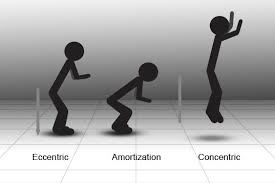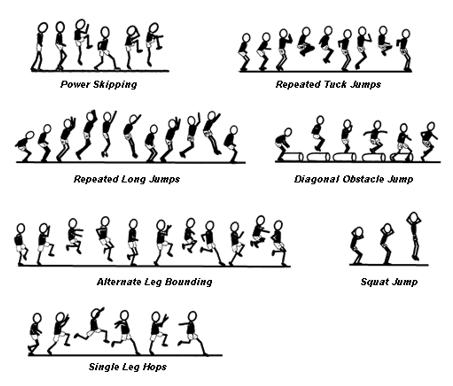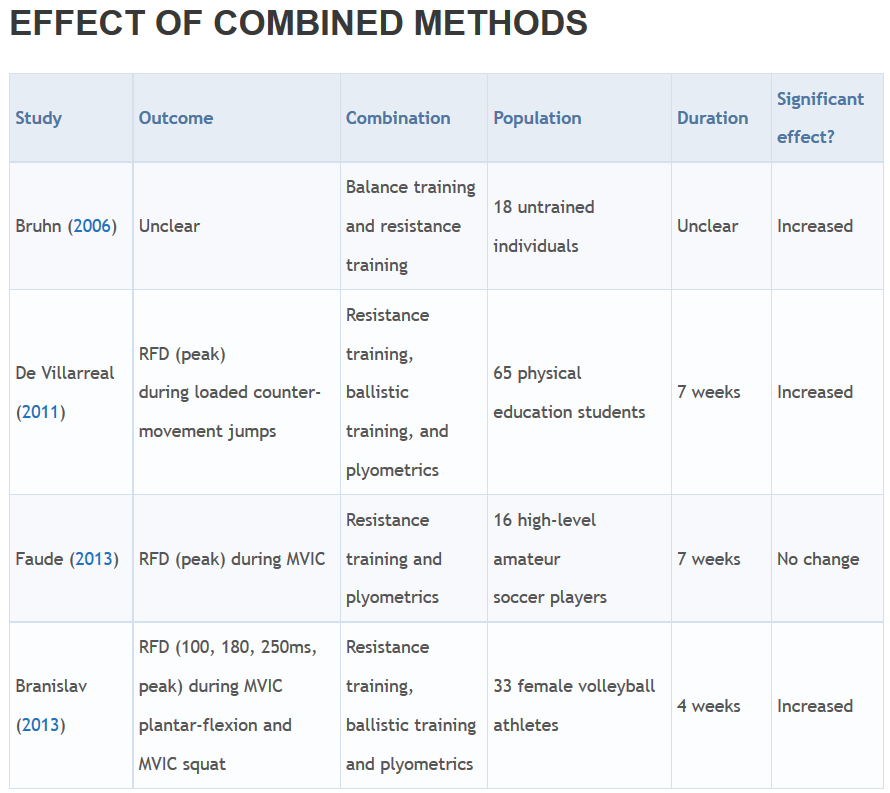Contents
- Introduction
- Plyometric training – Mechanisms
- The phases of plyometric training
- Pros and Cons
- Summary of studies
- Refferences

Introduction
Plyometric training is a training modality developed by Verkhoshanski in 1969 that employs high-speed controlled deceleration and muscle pre-stretching (eccentric loading) prior to executing rapid and powerful concentric contractions (concentric unloading). The quick eccentric phase activates and fires the muscle spindles, located in the muscle fibers, and a tremendous amount of force is generated through elastic energy that is stored in the tendons and muscles. Plyometric training, also known as jump or reactive training is a type of exercise that uses explosive movements such as bounding, hoping and jumping in which muscles exert maximum force in short intervals of time to develop muscular power. Specialized jumping or plyometrics are exercises that target one’s ability to change quickly from an eccentric to concentric muscle action, commonly referred to as the stretch-shortening cycle.
A form of training in which the individual reacts to the ground surface in such a way that they develop larger than normal ground forces that can then be used to project the body with a greater velocity or speed of movement. Plyometrics are primarily used by athletes, especially martial artists, sprinters and high jumpers to improve performance

Stretch-shortening cycle: Movements that involve a high intensity eccentric contraction followed by a high-force and rapid concentric contraction.
Concentric movement: Type of movement that involve muscles fibers shortening.
Eccentric movement: Type of movement that involes muscle fibers lengthening
Plyometric training – Mechanisms
A plethora of research have concluded that the primary goal of plyometrics is improving the responsiveness of the neuromuscular system. Such improvement has showed to enhance force production during the concentric phase of the stretch-shortening cycle. This happens thanks to two key mechanisms:
Myogenic: The utilization of the elastic energy storage in muscle-tendon tissue
Neurogenic: The alteration of the timing and firing rates of the motor units involved in myotatic reflex (spinal and supra-spinal influences)

Examples of Plyometric exercises
THE THREE PHASES OF PLYOMETRIC TRAINING
There are three distinct phases involved in plyometric training including
- Eccentric, or Loading phase
- Amortization, or Transition, phase
- Concentric, or Unloading, phase.
The first stage of a plyometric movement can be classified as the eccentric phase, but it has also been called the deceleration, loading, yielding, countermovement, or cocking phase [2]. This phase increases muscle spindle activity by pre-stretching the muscle prior to activation [3]. Potential energy is stored in the elastic components of the muscle during this loading phase. A slower eccentric phase prevents taking optimum advantage of the myotatic stretch reflex [4][5].
This phase involves dynamic stabilization and is the time between the end of the eccentric contraction (the loading or deceleration phase) and the initiation of the concentric contraction (theunloading or force production phase) [6]. The amortization phase, sometimes referred to as the transition phase, is also referred to as the electromechanical delay between the eccentric and concentric contraction during which the muscle must switch from overcoming force to imparting force in the intended direction [7]. A prolonged amortization phase results in less than optimum neuromuscular efficiency from a loss of elastic potential energy [8]. A rapid switch from an eccentric contraction to a concentric contraction leads to a more powerful response [7][6].
The concentric phase (or unloading phase) occurs immediately after the amortization phase and involves a concentric contraction resulting in enhanced muscular performance following the eccentric phase of muscle contraction [6][7][9]. This occurs secondary to enhanced summation and reutilization of elastic potential energy, muscle potentiation, and contribution of the myotatic stretch reflex [10][11].
Advantages and Risks of Plyometric training
Advantages of Plyometric training includes the following elements:
- Enhances exitability, sensibility and reactivity of the neuromuscular system
- Enhances rate of force development (RFD)
- Enhances motor unit recruitment and sychronization
- Enhances firing frequency/rate coding
- Desensitization of the golgi tendon organ
- Strenghens fast-twitch fibers
- Enhances muscle spindle activity
- Enhances metabilic efficiency
Risks of Plyometric training is defined in term of increased probability measured in the published studies and not direct cause.
It addresses the following elements:
- Muscle strains
- Tendon and ligament strains
- Prolonged or intorerable amount of stress can lead to exhausion



References
- T. L. Chmielewski, G. D. Myer, D. Kauffman, and S. M. Tillman, “Plyometric exercise in the rehabilitation of athletes: physiological responses and clinical application.,” J. Orthop. Sports Phys. Ther., vol. 36, no. 5, pp. 308–19, May 2006.
- P. Lundin and B. Wiliam, “A review of plyometric training,” Natl. Strength Cond. Assoc. J., vol. 13, no. 6, 1991.
- K. Kubo, H. Kanehisa, Y. Kawakami, and T. Fukunaga, “Influence of static stretching on viscoelastic properties of human tendon structures in vivo.,” J. Appl. Physiol., vol. 90, no. 2, pp. 520–7, Feb. 2001.
- P. V Komi and C. Bosco, “Utilization of stored elastic energy in leg extensor muscles by men and women.,” Med. Sci. Sports, vol. 10, no. 4, pp. 261–5, Jan. 1978.
- NATALIA and VERKHOSHANSKY, Depth jumping in the training of jumpers. 2012.
- K. E. Wilk, M. L. Voight, M. A. Keirns, V. Gambetta, J. R. Andrews, and C. J. Dillman, “Stretch-shortening drills for the upper extremities: theory and clinical application.,” J. Orthop. Sports Phys. Ther., vol. 17, no. 5, pp. 225–39, May 1993.
- M. L. Voight and D. L. Wieder, “Comparative reflex response times of vastus medialis obliquus and vastus lateralis in normal subjects and subjects with extensor mechanism dysfunction. An electromyographic study.,” Am. J. Sports Med., vol. 19, no. 2, pp. 131–7, Jan.
- G. J. Wilson, G. A. Wood, and B. C. Elliott, “Optimal stiffness of series elastic component in a stretch-shorten cycle activity.,” J. Appl. Physiol., vol. 70, no. 2, pp. 825–33, Feb. 1991.
- M. Ishikawa, E. Niemelä, and P. V Komi, “Interaction between fascicle and tendinous tissues in short-contact stretch-shortening cycle exercise with varying eccentric intensities.,” J. Appl. Physiol., vol. 99, no. 1, pp. 217–23, Jul. 2005.
- T. Fukunaga, Y. Kawakami, K. Kubo, and H. Kanehisa, “Muscle and tendon interaction during human movements.,” Exerc. Sport Sci. Rev., vol. 30, no. 3, pp. 106–10, Jul. 2002.
- D. E. Rassier and W. Herzog, “Force enhancement and relaxation rates after stretch of activated muscle fibres.,” Proc. Biol. Sci., vol. 272, no. 1562, pp. 475–80, Mar. 2005.